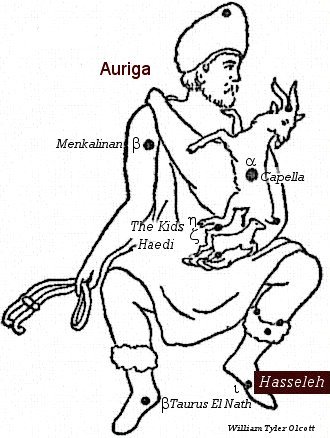| Fixed star: HASSELEH | |
| Constellation: Iota (ι) Auriga | |
| Longitude 1900: 15GEM15 | Longitude 2000: 16GEM38 |
| Declination 1900: +33.00′ | Declination 2000: +33.09′ |
| Right ascension: 04h 56m | Latitude: +10.27′ |
| Spectral class: K3 | Magnitude: 2.9 |
The history of the star: Hasseleh
from p.91 of Star Names, Richard Hinckley Allen, 1889.
[A scanned copy can be viewed on this webpage
Iota (ι) Auriga, Hasseleh, is a star in the left foot of the Charioteer.
Hasseleh was Al Ka’b dhi’l ‘Inan “the Heel of the Rein-holder” a title which other authors gave to gamma (γ) [gamma Auriga which marks the right Heel of the Rein-holder is now beta Taurus, El Nath marking one of the Bull’s horns].
Star Names, Their Lore and Meaning, Richard Hinckley Allen, 1889].
The astrological influences of the constellation Auriga
Legend: Auriga represents Erichthonius, son of Vulcan and King of Athens, who was the first to devise a chariot drawn by four horses which he used in order to conceal his greatly deformed feet. The goat and kids depicted in the constellation figure commemorate the goat upon whose milk Jupiter was reared, together with her offspring. [Robson, p.31.]
Influences: According to Ptolemy the bright stars are like Mars and Mercury. The constellation is said to give self-confidence, interest in social and educational problems. Happiness, but danger of great vicissitudes (changes of circumstances effecting one’s life). The native is fond of country life and may be a teacher or have the upbringing of young people. By the Kabalists Auriga is associated with the Hebrew letter Samech and the 15th Tarot Trump “The Devil”. [Robson, p.31-32.]
Auriga is one of the most fortunate constellations in the sky, but may still portend earthquakes if situated unfortunately as regard a solar eclipse. This constellation culminating in a chart presages honors, especially in the field of military and political endeavors. A modern astrologer might add sports whenever ancients mentioned military honors. [Fixed Stars and Judicial Astrology, George Noonan, 1990, p.15-16.].
The astrological influences of the constellation Auriga given by Manilius:
“The Charioteer lifts his team from ocean and wrests his wheels up from the downward slope of the horizon where icy Boreas lashes us with his bitter blasts. He will impart his own enthusiasms and the skills, still retained in heaven, which as driver of a chariot he once took pleasure in on earth (that is, the constellation is identified with Erichthonius). The Charioteer will enable his son to stand in a light chariot and hold in check the four mouths curbed with foam-flecked bits (Erichthonius, who is associated with Auriga, invented the quadriga, or four-horse chariot), guide their powerful strength, and keep close to the curve round which they wheel. Again, when the bolts have been drawn and the horses have escaped from the starting-pens, he will urge on the spirited steeds and, leaning forward, he will seem to precede them in their swift career; hardly touching the surface of the track with his light wheels, he will outstrip the winds with his coursers’ feet. Holding first place in the contest he will drive to the side in a balking course and, his obstruction delaying his rivals, deny them the whole breadth of the circus-track; or if he is placed mid-way in the press, he will now swing to a course on the outside, trusting in the open, now keep close to the pointed turning-post, and will leave the result in doubt to the very last moment. As a trick-rider too he will be able to settle himself now on one, now on a second horse, and plant his feet firmly upon them: flying from horse to horse he will perform tricks on the backs of animals in flight themselves; or mounted on a single horse he will now engage in exercise of arms, now whilst still riding pick up gifts scattered along the length of the circus. He will possess virtuosity in all that is connected with such pursuits.
“Of this constellation, I think, Salmoneus may be held to have been born imitating heaven on earth, he imagined that by setting his team of four on a bridge of bronze and driving it across he had expressed the crash of the heavens (referring to Phaeton’s disastrous attempt to drive the sun-chariot one day) and had brought to earth Jove’s very self; however, while counterfeiting thunderbolts he was struck by real ones and, falling after the fires he had flung himself, discovered in death that Jove existed. You may well believe that under this constellation was born Bellerophon, who flew amid the stars and laid a road on heaven (The Milky Way): the sky was the field over which he sped, whilst land and sea lay far beneath his feet, and his path was unmarked by footprints. By examples such as these are you to mark the rising figure of the Charioteer”. [Manilius, Astronomica, book 5, p. 305-309].
References:
Fixed Stars and Constellations in Astrology, Vivian E. Robson, 1923].
